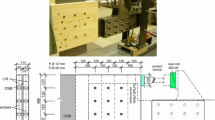Abstract
Dowelled joints, widely used in timber structures, are designed to transfer shear forces and bending moments between timber members. The anisotropic non-linear behaviour of the timber beneath the fasteners controls the stiffness of these joints. At the ultimate load-carrying capacity, the failure modes result from the shear stresses induced by the load distribution among the fasteners. The paper presents the experimental results obtained for beam to column joint with or without reinforcement using glued plywood plates. Based on these results, a two-dimensional finite element model was developed in two stages to describe the three-dimensional behaviour of the joint. At the single fastener scale, the model considers the non-linearity induced by the timber embedding and the fastener bending. At the structural scale, the modelling approach considers the timber as an elastic orthotropic material whereas each fastener is modelled by two non-linear springs. The elastic-plastic behaviour of each spring element is defined by the local scale model defined in two perpendicular directions. The load distribution among the fasteners is compared to the analytical results according to design rules. Considering the global load displacement curves, the results show that the modelling approach provides a good estimation of the structural response.
Résumé
Les liaisons par broches ou boulons, largement utilisés dans les structures en bois, sont conçus pour transmettre des efforts en cisaillement et des moments de flexion entre les éléments assemblés. Le comportement non-linéaire anisotrope du bois sous les organes d’assemblage contrôle la rigidité de ces liaisons. Au niveau de la capacité portante ultime, les modes de ruine résultent des contraintes de cisaillement induites par la distribution des efforts entre organes d’assemblage. Le papier présente les résultats expérimentaux obtenus pour un assemblage poteau-poutre avec ou sans renforcement par plaques collées en contre-plaqué. A partir de ces résultats, un modèle éléments finis bidimensionnel a été développé en deux étapes pour décrire le comportement tridimensionnel de l’assemblage. À l’échelle de l’organe unitaire, le modèle considère la non-linéarité induite par l’enfoncement du bois et la flexion de la tige. À l’échelle structurale, l’approche de modélisation considère le bois comme un matériau élastique orthotrope tandis que chaque organe d’assemblage est modélisé par deux ressorts non-linéaires. Le comportement élasto-plastique de chaque ressort est caractérisé par le modèle local défini dans deux directions perpendiculaires (plan de la tige et plan perpendiculaire). La distribution des efforts entre organes est comparée aux résultats analytiques donnés par les règles habituelles de calcul. En considérant les courbes globales force-déplacement, les résultats montrent que la modélisation donne une bonne évaluation de la réponse structurale.
Similar content being viewed by others
References
Bouchaïr A (1993) Modélisation non linéaire du comportement local des assemblages bois. PhD thesis. Blaise Pascal University, Clermont-Ferrand, France (only available in French)
Noguchi M, Komatsu K (2004) A new method for stiffness and strength in bolted timber-to-timber joints and its verification by experiments (II): bolted cross-lapped beam to column joints. J Wood Sci 50(5):2731–2738
Racher P, Galimard Ph. (1992) Les assemblages de structures bois. Annales de l’ITBTP 504:31–40 (only available in French)
Chen CJ, Lee TL, Jeng DS (2003) Finite element modelling for the mechanical behaviour of dowel-type timber joints. J Comp Struct 81:2731–2738
Larsen HJ, Jensen JL (2000) Influence of semi-rigidity of joints on the behaviour of timber structures. J Prog Struct Engng Mater 2:267–277
Bouchaïr A, Bocquet JF, Racher P, Peuchot B (1996) Behaviour of moment-resisting joints. In: Proceedings of the International Wood Engineering Conference (IWEC’96), vol 2. New Orleans-Louisiana, USA, 28–31 October 1996, pp 153–160
STEP1 (EU, Comett Programme) (1995) Timber engineering, basis design, material properties, structural components and joints, 1st edn. Centrum Hout, The Netherlands
Chenu E (1995) Etude et influence d’un renforcement par contreplaqué sur les couronnes en lamellé-collé. Engineer diploma thesis, CUST, Blaise Pascal University (only available in French)
Chaplain M (1996) Endommagement du bois dans la zone d’assemblage sous sollicitations cycliques: modélisation – Durée de Vie. PhD thesis, Blaise Pascal University, Clermont-Ferrand, France (only available in French)
Komatsu K, Kawamato N (1992) Analysis of glulam semi-rigid portal frames under long-term load, 25th meeting of CIB-W18A, Sweden, 14 pp
Koponen S (1991) Embedding characteristics of wood in the grain direction. Helsinki University of Technology, Report 25, 33 pp
Koponen S (1991) Modelling the behaviour of dowel type joints in wooden structures. Helsinki University of Technology, Report 26, 43 pp
Bouchaïr A, Racher P, Vergne A (1996) Effet des conditions aux limites sur le comportement des assemblages bois boulonnés. J Mater Struct RILEM 29:372–382
Kharouf N, McClure G, Smith I (2003) Elasto-plastic modelling of wood bolted joints. J Comp Struct 81:747–754
Foschi RO (1974) Load-slip characteristics of nails. Wood Sci 7(1):69–76
Whale LRJ, Smith I (1986) Mechanical timber joints Research report no. 18, TRADA, UK
Pasquet P (1998) Manuel d’utilisation du code de calcul Cast3M. CEA, Saclay, (in French, English information in web site)
Rahman MU, Chiang YJ, Rowlands RE (1988) Stress and failure analysis of double bolted joints in Douglas fir and Sitka spruce. International conference on timber engineering, vol 2. Seattle, USA, pp 131–142
Author information
Authors and Affiliations
Corresponding author
Rights and permissions
About this article
Cite this article
Bouchaïr, A., Racher, P. & Bocquet, J.F. Analysis of dowelled timber to timber moment-resisting joints. Mater Struct 40, 1127–1141 (2007). https://doi.org/10.1617/s11527-006-9210-0
Received:
Accepted:
Published:
Issue Date:
DOI: https://doi.org/10.1617/s11527-006-9210-0




